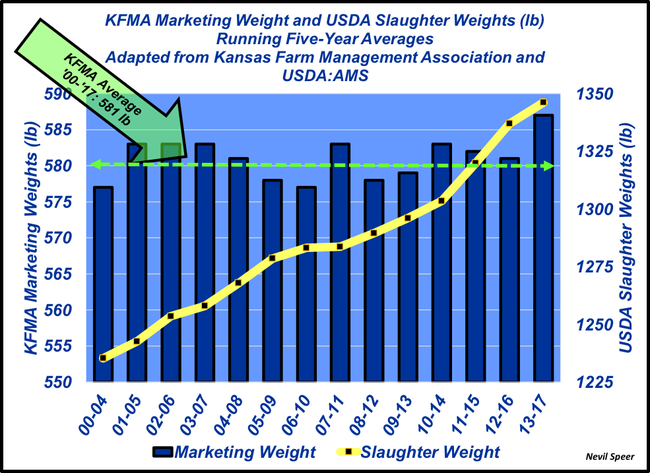Weaning weights remain flat while harvest weights are increasing. What gives?
April 11, 2019

David Lalman, Oklahoma State University beef cattle specialist, recently authored an important article in the Angus Journal that looks at trends in weaning weights in the U.S. (Weaning Weight Trends in the U.S. Beef Cattle Industry). Lalman notes, “…that trends for WW [weaning weights] in commercial cow-calf operations vary substantially by region of the country. However, there is considerable evidence that progress in WW may be limited by the production environment in commercial cow-calf operations. “
The article particularly caught my attention because it included analysis from the Kansas Farm Management Association (KFMA) – a resource that’s been regularly cited in this column. Most recently, based on historical review of KFMA data, Industry At A Glance noted:
Cowherds are getting bigger
The marketing rate hasn’t budged
Weaning (marketing) weights have plateaued
(Cowherds Keep Getting Bigger)
In reference to the last point and Lalman’s analysis, this week’s illustration highlights KFMA marketing weight versus USDA slaughter weight trends. Over time, weaning /marketing weights have stayed constant, while slaughter weights have surged higher. Lalman’s analysis is right on target.

That is, progress in weaning weights may be limited by production environments and/or marketing strategies in most cow-calf operations. Stated another way, many cow-calf operators haven’t fully realized the benefit of selecting for more growth at weaning.
To that end, Lalman cogently summarizes the phenomenon this way:
“Perhaps one of the most important takeaways from this study is that commercial cow-calf producers need to keep good records in order to monitor progress in WW and enterprise cost of production over time. Assuming a lack of significant progress in calf WW, efforts to enhance profitability should focus on reducing cost of production and/or capturing value of genetic potential for post-weaning performance and carcass value.”
(The full report can be found in the Journal of Applied Animal Science)
Based on these long-run trends and Lalman’s analysis, how can your operation gain some ground in terms of profitability – either on the cost side or doing a better job of capturing the genetic potential of your calf crop?
About the Author(s)
You May Also Like





